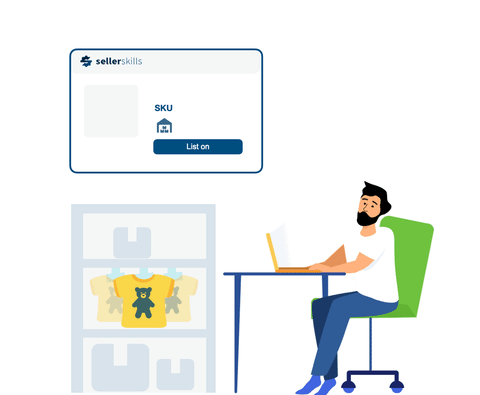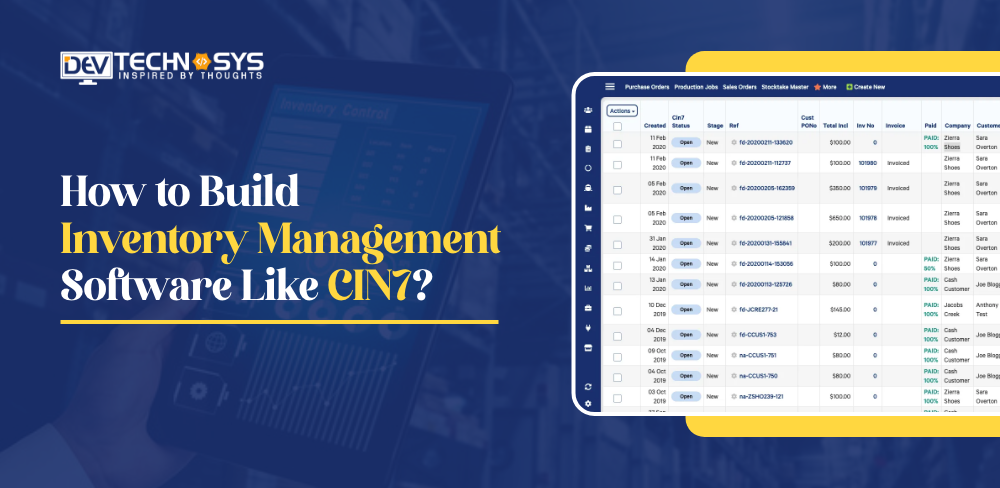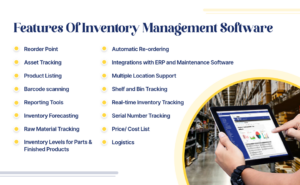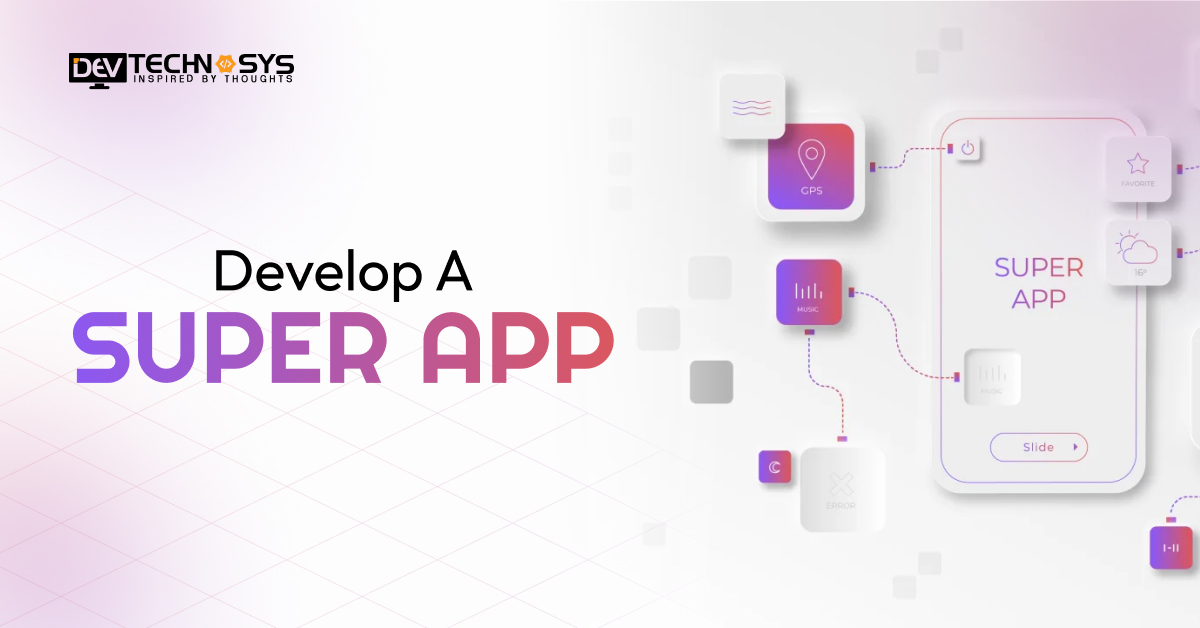In today’s business world, who doesn’t want to build inventory management software? Every company must deal with inventory management. These issues are common for any company that connects to the supplier network.
It is difficult to solve time-consuming problems such as inventory counting, backorders, out-of-stock, and problems caused by poor demand planning. This software is essential. In this instance, inventory management software development like CIN7 is essential.
Many business owners around the world have switched from their old inventory management system to modern software. This includes everything from record management and reporting to projecting and planning inventory.
Inventory management software like CIN7 provides businesses with a range of tools that help them manage their inventory handling, ordering, and monitoring.
This blog aims to give you a complete understanding of inventory management software development. It is crucial for supply chain businesses to be able to manage their inventory electronically. This blog will give you an overview of some key features, steps, and costs that should be considered when developing inventory management software like CIN7.
So let’s begin.
What is Inventory Management Software?

An inventory management software (IMS), is software that tracks inventory, controls stock levels, and handles orders, returns, reports, and other tasks. The efficiency, precision, and speed of operations are all improved by automating formerly manual procedures.
There are two types of IMSs. One is a perpetual system that manages inventory in real-time. The other is a dynamic system that manages inventory continuously. A periodic system that periodically counts stock and gives periodic updates.
While periodic systems are simpler and cheaper and have fewer capabilities, perpetual ones are more complex and require greater investments. Perpetual systems, on the other hand, are more sophisticated and provide real-time visibility, control, and visibility.
Different businesses will require different approaches and solutions. An IMS can be used alone or integrated with additional corporate management platforms such as enterprise resource planning, warehouse management systems, supply chain management platforms, etc.
CIN7-overview
Cin7, a cloud-based, all-in-one solution, provides visibility, customization, and reporting to enable efficient inventory management throughout the supply chain.
Cin7 has built-in production and warehouse, POS, B2B eCommerce, and a growing number of third-party integrations. Cin7’s “Connected Inventory”, which is optimized for multichannel businesses that require robust inventory management at a fraction of the price of an ERP, bridges the gap between sales channels and suppliers to provide end-to-end supply chain control.
Cin7 is headquartered in Auckland, New Zealand. There are also offices in the United States of America and the United Kingdom. Let’s now look at some market statistics for CIN7 inventory software.
Market Stats of CIN7 Software
- The inventory Management Software Market size was valued at USD 1213.97 Million in 2020 and is projected to reach USD 2998.55 Million by 2028, growing at a CAGR of 11.9% from 2021 to 2028.
- The major players in the market are FreshByte Software, Galley, LogixPath, LLC, Tree Tracker, Limble CMMS, Snappii, Elite Seller, and EZRentOut.
- The top three of Cin7 Inventory Software’s competitors in the Point Of Sale (POS) category are Shopify with 63.46%, MyTime with 7.39%, and Square Point of Sale with a 5.44% market share.
- Around the world in 2023, over 188 companies have started using Cin7 Inventory Software as a Point Of Sale (POS) tool.
- The top three geographies of Cin7 Inventory Software for point-of-sale-pos are the United States with 130(37.14%), Australia with 92(26.29%), and New Zealand with 43(12.29%) customers respectively.
- Looking at Cin7 customers by industry, we find that Information Technology and Services (11%), Retail (10%), Hospital & Health Care (9%), and Computer Software (7%) are the largest segments.
- 52% of Cin7 customers are in the United States, 13% are in Australia, 9% are in India and 9% are in the United Kingdom.
How does inventory management software function?
To manage complicated inventory tasks, you can use inventory management software as a standalone program or as part of an ERP system. It can be used in conjunction with RFID tags and barcode scanners for order details to store inside the system.
Warehouse staff can easily locate ordered items and update inventory accordingly by using these systems. This system is a true success in real life because of its real-time item tracking.
Inventory management software helps you automate and streamline warehouse tasks. This software helps you to save time, energy, and valuable resources for supply chain operations.
Top 5 alternatives of inventory management software like CIN7
1. Brightpearl
Brightpearl, a digital operations platform that is tailored for retailers and omnichannel merchants, was created. It was designed to help wholesalers and retailers increase their operational agility so they can respond quickly to market changes, improve customer experience, and increase sales.
It is the best inventory management software that provides many features, including Inventory and order management, Inventory and demand planning, and Warehouse management.
2. Fishbowl
Small to medium-sized firms can utilize Fishbowl as a tool for managing their production and warehousing operations. This tool includes material billing, floor control, material management software, and inventory control.
The features include Multi-location inventory management and Order management software, Part tracking, multi-currency sales, and purchasing.
3. Skubana
Skubana software is order fulfillment and inventory management software that can be used by multichannel retailers and brands. It allows you to combine multiple operations software into one cloud-based platform.
This makes it ideal for high-volume marketplace sellers. One-click integrations, Shipping tools, and order processing are just a few of the many features offered by Skubana.
4. Sellercloud
Sellercloud is an e-commerce platform that supports multiple channels. It is one of the best warehouse inventory management software. It can sync online inventory and distribute data, and turn it into real-time insight.
Sellercloud includes an automated inventory tool that supports warehouse management, inventory tracking, and shipping times.
5. NetSuite
 NetSuite (or Enterprise Resource Planning Solution) is a traditional ERP. It is a single-size-fits-all ERP that offers features such as inventory management and accounting for medium-sized to large e-commerce platforms.
NetSuite (or Enterprise Resource Planning Solution) is a traditional ERP. It is a single-size-fits-all ERP that offers features such as inventory management and accounting for medium-sized to large e-commerce platforms.
The functionality includes email marketing, customer relationship management, as well as custom add-ons.
Advantages of Inventory Management Software
Before you commence to build inventory management software, you must first get to know the advantages of this software. So let’s have a look at them.
1. Automation
Inventory management is made easy with special software. You don’t need to spend a lot of time sifting through spreadsheets when you can view all the details you require and how your inventory has evolved over time. It’s easy to add data to your system using specialized software.
2. Simple communication
Your employees can have access to your inventory web app so that they know what is in stock and what they need for shipping to specific shops. You can receive customer requests automatically from multiple brick-and-mortar stores.
3. Planning is effortless
An inventory management web application can provide historical inventory data that you can use to plan future orders or shipments. This data can help you predict the demand for certain products in your physical or e-commerce store.
4. Lower risk
Online retailers are prone to overselling, which can lead to unhappy customers and loss of control. Using a system for inventory control that maintains you updated on how much goods are left to ship will help you prevent this.
Analytics and reporting allow you to predict and reduce your risks. An inventory management system can also mitigate other risks such as overstocking and understocking.
5. Analytics
Planning, risk mitigation, and analysis are all made easier with the use of analytics. Your inventory management software absolutely needs this function. It provides insight into your inventory situation and allows you to control your business.
Key features of inventory management software like CIN7
The first thing you should ask the team responsible for inventory management software development is what features you would like to add before they build inventory management software. You may have many things you wish you could integrate into your system. Here are some common features.
1. Reorder Point:
Inventory management software allows you to see a list of all the products and quantities required for stock. These points can then be programmed into the software to alert the manager about the need to reorder the product. This will prevent stock shortages and overstocking.
2. Asset Tracking:
Utilizing their barcode, radio frequency identifier, or lot tracking number, you may utilize this function to keep track of items in the warehouse or shop.
3. Product Listing:
This application will organize and manage your inventory with the aid of crucial information like price, availability, and SKUs. You can create alternative items for each item based on their elementary attributes, and organize them in a systematic way.
4. Barcode scanning:
This allows the tracking of products by using their barcodes. This easy exchange of electronic data is possible via smartphones without the need for expensive scanning hardware.
5. Reporting Tools:
There are many reporting tools available that can help you create inventory management software’s total reports, order history, or transaction reports. You may establish a fluid workflow with the aid of these technologies. You will discover which goods are lucrative, which items require to be reordered, and more about the products that are currently in stock.
6. Inventory Forecasting:
This feature helps you decide how much stock you need to keep your company stocked. These situations can have negative consequences for your business and could result in lower sales and decreased productivity.
7. Raw Material Tracking:
This feature allows you to determine if enough raw material is available for new production jobs. This feature will help you reduce labor costs and direct your workforce towards more reliable and productive alternatives.
8. Inventory Levels for Parts & Finished Products:
This allows you to keep track of the finished goods in your warehouse or store so that they can be shipped immediately to customers. It also tracks the availability and cost of any parts that are needed to make a custom product.

9. Automatic Re-ordering:
With the use of this tool, you may automatically reorder goods depending on your reorder points. Automatic purchase orders are automatically generated when the stock reaches its minimum level. This allows you to keep track of your inventory at all times.
10. Integrations with ERP and Maintenance Software:
To save time, you can integrate your inventory management system with ERP.
11. Multiple Location Support:
Multiple warehouses or stores can be tracked and managed to maintain track of stock availability.
12. Shelf and Bin Tracking:
Inventory managers may instantly know the precise location of each product in their warehouse thanks to this feature. Your organization’s requirements will be taken into consideration when designing your inventory management system. You’ll be able to simplify and streamline your job as a result.
13. Real-time Inventory Tracking:
This feature allows you to track inventory in real time between warehouses or stores. If you want to integrate all these features into your software, you must hire a dedicated team of developers who can easily do the task.
14. Serial Number Tracking:
This feature allows you to manage hundreds of thousands of serial numbers. From the moment of arrival until the time they are issued, they are retained in the system indefinitely. This information is especially useful in verifying the return of an article from your computer.
15. Price/ Cost List:
This allows you to specify different price levels for items and then you can offer any level to customers.
16. Logistics:
The movement and storage of products and resources are made even more transparent by third-party logistics tools like transport analytics and trackers. Both warehouse managers and users can track the location of the goods and their arrival time.
How to build inventory management software like CIN7?
You have decided that your e-commerce store needs an inventory management system. You now need to create it. Let’s look at the steps to build inventory management software.
1. Form a vision
Before you build inventory management software, it is important to understand what you want from your inventory management system. What is it supposed to be capable of and what business requirements should it meet? You know your business better than anyone, so off-the-shelf solutions are not always able to meet industry-specific requirements.
Create a vision for your company, and then list the features or functionalities you’d like to see in your program. You don’t have to be specific. Someone with software engineering expertise will be able to convert your ideas into technical solutions.
2. Find a Developer
Next, you need to find the vendor who will build inventory management software. You have a few options:
Hiring an in-house developer:
This can be quite difficult because there is so much competition in the market for developers. It is hard to find, keep and hire dedicated developers. You may also lose time and money if your software is not available immediately.
If you hire someone in-house, then you will need to pay a regular salary and bonuses, taxes, as well as money for equipment and workspaces.
Hiring a freelancer:
You only pay for the time that the developer spends working on your inventory management software project. This includes bonuses, taxes, and hiring expenses. Freelancers can be difficult to manage, especially when you have multiple people, such as a quality assurance specialist, developer, or business analyst.
Partner with a software development company:
This is the greatest option if you need to obtain high-quality software immediately. A software development company’s development costs are comparable to hiring a freelancer and will be significantly less than hiring an in-house programmer.
A software development company in Dubai can provide the expertise you need to build your software within your budget and on your time.
3. Create a plan
It’s now time to plan. The planning process will start as soon as the development specialist has been contacted and has been given your vision, your budget, and your timeframe expectations. The company recommends creating a technical specification.
This should include all details about your product’s features and technology stack. APIs, integrations, and business logic. As a consequence, you can be sure that everyone is on an identical page and that you will achieve your goals.
4. Develop and Test
Once you have confirmed functionality, budget, timeline, and other details, it is time to build inventory management software like CIN7. Although an inventory management system can be very simple, it requires knowledge of data manipulation.
Additionally, it is best to test each feature simultaneously. so, Once you have developed the software, the testers will test the bugs and errors present in the software.
5. Release and Maintain
once you have thoroughly tested and building your software, it is time to make it available to your employees and show them how to use it within your warehouse.
You will still need to spend 15% to 20% of your annual development budget on maintenance to keep the software up-to-date. This is for security and performance reasons.
Tech Stack used for inventory management software
For warehouse employees, a mobile app can be used in conjunction with a web-based inventory management system. They will scan barcodes to receive orders and process them. A dashboard is an inventory management system.
However, it provides all the information you need to manage operations and make decisions. You can implement this functionality with basic web technologies. Here are tech stacks that are approved by a web development company.
Programming languages:
PHP
Python
JavaScript
Ruby
Frameworks:
Symfony
Laravel
Django
Ruby on Rails
Flask
Databases:
MongoDB
PostgreSQL
MySQL
Servers:
Apache HTTP Server
Nginx
Cost Factors of Inventory Software like CIN7
With basic functionality, the inventory management software development cost is between $25,000 and $35000. The cost of an advanced IMS system with more complex features can rise to anywhere from $40000 to $50000.
However, the final cost of software depends on many factors such as software functionality, technical complexity, and developer location. Experience, development hours, etc.

The final cost to build inventory management software will vary depending on the location of your dedicated development team. USA developers will charge $200/hr, which is quite high when compared to an Asian developer who charges $40/hr.
Conclusion
Inventory management software development has cured the business world’s biggest problem of managing inventory. Inventory management software helps businesses track, organize, and manage their products and raw materials.
This allows them to deliver products to customers. Moreover, there are many software options on the market, and more are being developed. This software is very popular with businesses that need to manage their storage needs.
As a result, now is the time to incorporate this into your business operations if you haven’t already. You can take assistance from a software inventory management company that can build inventory management software and help in reaching your business to another level.
FAQ
What are the difficulties that can be encountered during the process of developing inventory management software?
Some challenges that can arise when you build inventory management software include accurately tracking inventory levels and locations, integrating with other systems such as accounting or purchasing, handling data security and privacy concerns, and designing an interface that is user-friendly and meets the needs of different types of users. Additionally, the software must be able to handle different types of inventory, such as perishable goods, and adapt to changes in inventory levels and demand.
Which is the best software for inventory management?
The most popular inventory management software is Zoho Inventory, ecomdash, EZOfficeInventory, etc. You can create custom software to improve control and flexibility when managing inventory operations.
How much time does it take to build inventory management software?
The time it takes to build inventory management software can vary greatly depending on factors such as the complexity of the system, the size of the development team, and the technology used. However, it typically takes 4-6 months to 8-9 months to develop and fully implement such a system.
What are the difficulties that can be encountered during the process of developing inventory management software?
Some challenges that can arise when you build inventory management software include accurately tracking inventory levels and locations, integrating with other systems such as accounting or purchasing, handling data security and privacy concerns, and designing an interface that is user-friendly and meets the needs of different types of users. Additionally, the software must be able to handle different types of inventory, such as perishable goods, and adapt to changes in inventory levels and demand.
Which is the best software for inventory management?
The most popular inventory management software is Zoho Inventory, ecomdash, EZOfficeInventory, etc. You can create custom software to improve control and flexibility when managing inventory operations.
How much time does it take to build inventory management software?
The time it takes to build inventory management software can vary greatly depending on factors such as the complexity of the system, the size of the development team, and the technology used. However, it typically takes 4-6 months to 8-9 months to develop and fully implement such a system.


















